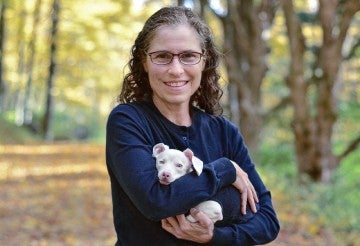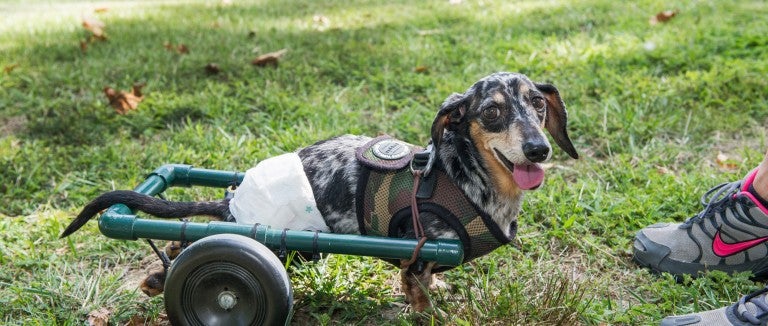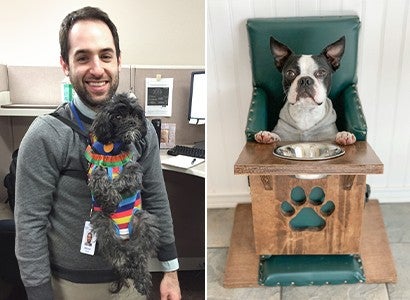The young Belgian Malinois was only supposed to stay with Lisa Kauffman for a month. Kauffman, HSUS wildlife protection public policy program manager, welcomed Emmie into her home last October after she was found as an underweight stray and brought to a California shelter. Kauffman planned to care for Emmie temporarily until a friend could adopt her and train her for search and rescue work.
During the first few days, Kauffman noticed Emmie regurgitating water after drinking. At first, Kauffman thought it was nerves. But after a week with no change, Kauffman took Emmie to the veterinarian, who diagnosed her with megaesophagus—an incurable condition where the esophagus is enlarged and loses its ability to move food into the stomach.
Because of the intensive care required for dogs with her condition—such as keeping them upright after eating to ensure they digest their meals—Emmie was no longer a candidate for search and rescue work. Kauffman had formed a close bond with the dog and decided to adopt her.
I enjoy taking care of animals that are a little more needy than others; it gives me a lot of pleasure. I like seeing them succeed.
Dr. Melissa Shapiro, the Humane Society Veterinary Medical Association
Seeking information
Caring for a disabled or chronically ill pet can be a time- and resource-intensive commitment. It can also be emotionally draining. During the first few weeks after adopting Emmie, Kauffman often broke down in tears. Now, months later, Emmie has gained weight and her energy levels are up. It’s still a difficult journey, but learning about Emmie’s disease helped reduce Kauffman’s stress.
Kauffman found information and support in online groups for owners of dogs with megaesophagus. One member shared instructions for building a “Bailey chair”—a highchair that allows a dog to sit upright during feedings, which helps food and water move down the esophagus and into the stomach. Another made Emmie a neck pillow to help prevent her from regurgitating overnight.
“You will learn a lot from other people who are dealing with the same thing with their pets, and you’ll learn good questions to ask your vet and how to advocate for your animal’s care,” says Kauffman.
Consulting the experts
Kathryn Kullberg, HSUS director of marine and wildlife protection, had owned Buster for 10 years when he was diagnosed with diabetes in 2021. She had experience caring for diabetic cats from her pet-sitting days, but the diagnosis was still overwhelming. Kullberg began giving Buster daily insulin shots, yet his blood glucose levels stayed elevated. A specialist discovered that a pituitary tumor was causing his diabetes.
Buster received stereotactic radiation therapy to target the tumor and his blood glucose levels went down. He’s had some speedbumps in his recovery but is now stable. Kullberg appreciates the reassurance her specialist provided. “It felt great to have someone in my corner,” she says.
Like others, Kullberg found online groups helpful, but she cautions against relying solely on advice from other pet owners. “Do your own research but ultimately trust your veterinarian,” she adds.
Dr. Melissa Shapiro, Connecticut state representative for the Humane Society Veterinary Medical Association, works with disabled pets every day. Not only is she a small-animal veterinarian and advocate for disabled pets, but she’s also adopted many disabled animals, including Piglet, a deaf and blind dachshund-Chihuahua mix. When she adopted him as a puppy five years ago, he was very anxious. Shapiro taught him tap signals, which involve tapping different parts of his body to communicate messages such as “sit” and “go pee.” He’s much less anxious now, and he and Shapiro visit classrooms to teach children about resilience, inclusion and empathy. (The Piglet Mindset educational program is housed on pigletmindset.org. Shapiro also shares photos and stories on Instagram.)

Be realistic—and enjoy the ride
Shapiro says caring for a disabled pet is incredibly gratifying. “I enjoy taking care of animals that are a little more needy than others; it gives me a lot of pleasure,” she says. “I like seeing them succeed.”
At the same time, she adds, potential adopters should assess their ability to manage a pet’s condition before taking on the responsibility. “If you have an animal that needs to be medicated, you need to be able to medicate that animal, you need to be home at the times they need to be medicated,” Shapiro says. If you have a pet who needs a wheelchair, your house needs to be accessible, she adds.
Financial and time commitments are also important considerations. Kauffman feeds Emmie four times a day to ensure she is getting adequate hydration and nutrition. Afterward, she supervises Emmie in the Bailey chair for 30 minutes to make sure the food goes down. Williams recalls swapping out Luna’s food every couple of months when she lost interest in meals and needed something novel to try.
Being the primary caregiver to a disabled pet may sound daunting at first, but “once you start doing it, believe it or not, things become easier, things become familiar,” Shapiro says.
Kullberg jokes that she can now give Buster his insulin shots with her eyes closed. “It’s like second nature,” she says.
Caring for Buster has given Kullberg the confidence to consider adopting a disabled pet in the future. “It’s just something you learn to live with, and you’re giving them a second chance at life because most people want a healthy pet,” she says. “Opening your heart to a special needs or chronically ill pet is really rewarding. When [Buster] has a good day, it makes me feel great.”
Want more content like this?
This was written and produced by the team behind All Animals, our award-winning magazine. Each issue is packed with inspiring stories about how we are changing the world for animals together.
Learn MoreSubscribe

